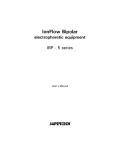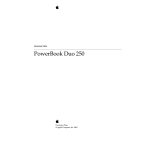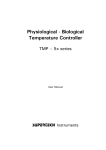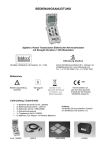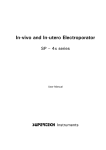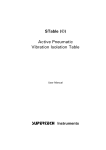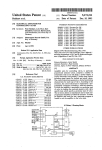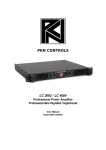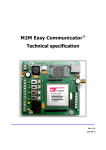Download User Manual
Transcript
BioStim Battery-supplied Floating End-stage & Battery Manager User's Manual SUPERTECH Important notes The battery pack is very sensitive! It will be destroyed on irreversible way, if the Endstage has been forgotten in Power ON position, and the battery pack is overdischarged, even in one time. You should take special care of this aspect. The battery pack can not be overcharged, because the Battery Manager has got an automatic charger, and conditioner circuitry. The Charging of Battery function of the Battery Manager can be activated even for prolonged periods. For the sake of the battery pack the Power ON switch should be turned on for the necessary time periods only. But there is a very important aspect to keep in mind always. The Power ON switch should be turned on before connecting the output wires to the biological object! It is also necessary to disconnect the output of the Endstage from the biological object before turning the Power switch off! The reason, why it is important is the following: this equipment is not a simple stimulus isolator unit, but an isolated End-stage. It means, that the floating electronic sections (the Constant Current, and the Constant Voltage Generators) are isolated from the other circuits via 4 kV isolation security, and very small isolation capacity optocouplers, but the isolated, floating sections are quite difficult electronic circuits. These circuits are powered from 120 V supply voltage. During the switching on period (in a few milliseconds of time window) these circuits are “standing up”. Similarly, in the switching off period the voltages of these circuits are “demolished”. These circuits are designed to work perfectly in normal operating conditions, but the switching on, and switching off transients are not normal working periods. In these short time intervals huge voltage transients (approximately 100 V in amplitude) voltage spikes are appeared at the output connectors. These spikes make catastrophic electrical shocks for the biological object. The parts of the BioStim universal biological stimulator system The BioStim system is divided into two functional parts. The time parameters are generated by the fully digital BioStim Controller, and the analogue voltage and current sources are implemented in the End-stages. The parts of the system are manufactured as independent equipments. On one hand it results a more flexible and variable system, because the similar parts (e.g. the End-stages) are compatible, and they can be changed easily. On the other hand the divided system meets the special experimental requirements much better, because the analogue End-stages can be located close to the biological objects in the shielded environment, but the digital BioStim Controller, can be placed anywhere else. BioStim Computer Interface is an alternate of the BioStim Controller in special cases. You can find detailed descriptions about each elements of the BioStim system in the appropriate manuals. Battery-supplied Floating End-stage It can be used for the most sophisticated, noise-sensitive microelectrode experiments (for example multi-electrode, and patch clamp environments). It passes extremely small, practically zero hum noise into the biological tissue. There is a Constant Current Generator, and a Constant Voltage Generator built into this End-stage. The output of the End-stage can be switched between Constant Current, and Constant Voltage modes on-the-fly, during the experiment. It is a very useful feature, because the first stimulating trials can be carried out in the secure Constant Voltage mode. If the experiment is qualitatively working, the End-stage can be switched into Constant Current mode, where the electric charge can be defined exactly. The only limitation is, that the alternation from the Constant Current Generator to the Constant Voltage Generator, or vice versa, must not be done during an active output pulse, only in the pauses between the pulses. If you would do this action even so, than an unwanted voltage, or current transient would be appeared at the output connectors (because the momentary voltage, and current levels of the two generators are different in the duration of the pulses, and they would be equalized through the biological object connected to the output connectors). The Constant Voltage mode has got two ranges: 10 V, and 100 V of full scale. The Constant Current mode has got two ranges: 100 µA, and 10 mA of full scale. The output amplitude in the selected range can be set using a 10-turn calibrated helical potmeter on the front panel. The nonlinearity (total amplitude error) of the End-stage is less than 5%. This End-stage is supplied from its built-in rechargeable battery pack. This model has got an additional accessory, the Battery Manager unit, which is an automatic, and precision battery charger, and conditioner equipment. The nominal voltage of the internal battery pack is 120 V, and its nominal capacity is 170 mAh. With a new battery pack the average operation time (the efficient working period between two charging actions) is approximately 12 hours. If you take care of the battery pack, its lifetime will be two years at least, if the End-stage is used every day, the battery pack is charged if necessary, but the battery is never over-discharged. The Battery-supplied Floating End-stage is optimized for that aspect, that it does not generate any electric noise, because of its battery-powered scheme. According to this feature it can be placed close to the experimental object anywhere, even in a seriously shielded environment. Front panel controls The middle switch at the top section is the selector of the working mode of the Endstage. It can be used to switch between the Constant Current, and Constant Voltage modes. This switch can be alternated anytime during the pauses. Left to the working mode switch there is the range selector of the Constant Current Generator. The Constant Current mode has got two ranges: 100 µA, and 10 mA of full scale. This switch is ignored, if the Constant Voltage mode is selected by the working mode (middle) switch. Right to the working mode switch there is the range selector of the Constant Voltage Generator. The Constant Voltage mode has got two ranges: 10 V, and 100 V of full scale. This switch is ignored, if the Constant Current mode is selected by the working mode (middle) switch. Most left at the bottom section there are the output connectors. These two connectors are the floating output connectors of the End-stage. They are compatible with the 4 mm banana jacks. Furthermore they have got isolated plastic screws to fix simple wires up to 1 mm in diameter. Be careful! The output connectors are high voltage connectors! They are especially dangerous to touch in the Constant Current mode, because the compliance voltage (120 V) can be present here! Next to the output connectors there is the output Polarity selector switch. The output connectors are identical except their polarity. There are many experimental arrangements, where the polarity of the stimuli has no importance. But if the polarity is important, it can be changed easily with this switch. This switch can be alternated anytime during the experiment. In the middle at the bottom section there is the Control indicator LED. This is a dim, red LED. It is used to indicate visually the presence of the digital pulses at the input of the End-stage. Next to the Control LED there is the Pulse Amplitude potmeter. The amplitude of the output pulses (always in the selected range) can be set using this 10-turn calibrated helical potmeter. If the scale of this potmeter shows 10.00 than the full scale value of the actually selected range is passed to the output connectors. If the scale of this potmeter shows 0.00 than zero value is passed to the output connectors. Most right at the bottom section there is the Power ON switch. Never forget it in switched on position for prolonged periods, because the internal battery pack will be destroyed on irreversible way if you over-discharge it. There is no “power-on” indicator LED on the Battery-supplied Floating End-stage, because the current consumption of a LED is as high as the current requirement of the complete Endstage. By eliminating the LED the operation time (the efficient working period between two charging actions) of the End-stage was increased efficiently. The Power ON switch should be turned on before connecting the output wires to the biological object. It is also necessary to disconnect the output of the End-stage from the biological object before turning the Power switch off (see the Important notes section, too). The connectors at the back side At the left side there is a 3-pole, high voltage connector. It is used to connect the End-stage to the Battery Manager with a high-voltage cable. You should always use the special cable provided by Supertech. Never touch the pins in the plugs of this interconnecting cable, because high voltage is present at both of the ends of this cable! The only safe position, if this cable is connected to both of the equipments. Avoid to use other battery charger equipments than the Battery Manager, because the internal battery pack has got special requirements to meet. In the middle there is the Internal Floating Shield connector. It is compatible with the 4 mm banana jacks. Furthermore it has got an isolated plastic screw to fix a simple wire up to 1 mm in diameter. Since the Battery-supplied Floating End-stage is designed to work in a seriously shielded environment, it is essential to shield the internal circuitry rigorously. The Internal Floating Shield connector is used for this purpose. You should connect it to the common Ground point of the Faraday-cage. The best point where it should be connected exactly can be found during the pilot experiments, when the lab is set up at first time. Above the Internal Floating Shield connector there is a switch, what can be used to disconnect the Battery-supplied Floating End-stage from the Battery Manager. Usually the Battery Manager does not generate hum noise, if its mains switch is turned off, but under special circumstances (e.g. with extremely high impedance electrodes, or with very high gain set in the amplifier) you can find hum noise in the Faraday-cage. In such situations you can disconnect the End-stage, and the Battery Manager completely (galvanically) with this switch. At the right side there is the Isolated Control connector. It is used to connect the Endstage to the BioStim Controller, or to the BioStim Computer Interface. You should always use the special cable provided by Supertech. Avoid to use other controllers directly, except the BioStim Controller, or the BioStim Computer Interface. Any external pattern generator equipment, or any output port bit of a data acquisition card of a PC should be connected through the BioStim Controller, or through the BioStim Computer Interface, on standard TTL levels, at their appropriate connectors. Battery Manager It is very important to keep in mind to take care of the battery pack always. The battery pack is very sensitive. It can not be overcharged, because of the sophisticated Battery Manager equipment. The only danger for the battery pack is, if the End-stage is forgotten in switched on position for a prolonged period, and the battery pack is over-discharged below the nominal lowest voltage. This action destroys the battery pack. To reach the longest lifetime of the battery pack, it is the best way to charge it fully, and discharge it fully, but not below the lowest voltage level, what can be indicated by the Battery OK LED. During active, stimulator usage of the Battery-supplied Floating End-stage (if its Power switch is ON) the green mains switch of the Battery Manager should be switched off, because its line frequency transformer generates a rude noise in the shielded environment. The Battery Manager has been designed to support Charging of Battery, and Checking of Battery operating modes. Its mains switch should be turned on only in these two operating modes. The Charging Current LED at the front of the Battery Manager is a visual indicator. Its brightness is proportional to the actual charging current. It is always lighting a little bit (in Charging of Battery function), even when the battery pack is charged completely, because a small current is always provided for the battery pack against its self-discharge. The Battery OK LED at the front of the Battery Manager is an indicator driven by an internal comparator circuitry. If you push the Battery Test button (in Checking of Battery function), a dummy load of 20 mA is connected to the battery pack. This load is higher, than the total current consumption of the End-stage. During the application of this huge load current, the comparator checks the voltage of the battery pack. If its voltage is higher, than the nominal lowest voltage, than the Battery OK LED is lit. There is a drawing of interconnections of the Battery-supplied Floating End-stage, and the Battery Manager in the Appendix. There is a summary of the operating modes of the Battery-supplied Floating Endstage, and the Battery Manager in the Appendix. Further development Until now we have developed many different features for the Battery-supplied Floating End-stage, as it is listed above. In spite of this, if you can not find the appropriate function for your special task in our actual choice, and this function seems to be interesting for other our customers, we will develop this function especially for you. It is our method, how we improve the features of our equipment. We collect all the notices and feedbacks of our customers, and we implement their (may be your) knowledge into the features of BioStim. Warranty We give you full warranty service, including rest parts for the period of 3 years by default. Longer warranty periods can also be defined and agreed (the actual conditions should be discussed before placing the order). The warranty is valid only in that case, if the End-stage is controlled by the BioStim Controller, or by the BioStim Computer Interface. The Battery-supplied Floating End-stage is supported with full warranty, except the internal battery pack. Since the lifetime of the battery pack is a subject of the care of the user, Supertech can not provide warranty for the battery pack. International technical hotline by phone: (36) (20) 9234-386 Technical hotline by email: [email protected] Mains OPTIONALLY: 115V to 230V AC Transformer High voltage Battery Manager BioStim Controller, or Pulse Output Stimuli BioStim Computer Interface BioStim Battery-supplied Floating End-stage Biological object Interconnections of the Battery-supplied Floating End-stage, and the Battery Manager IMPORTANT! The Power ON switch should be turned on before connecting the output wires to the biological object. It is also necessary to disconnect the output of the End-stage from the biological object before turning the Power switch off (see the Important notes section, too). The most important operating mode selector is the Power ON switch of the Batterysupplied Floating End-stage. If it is in Power ON position, the End-stage is working. In this situation (during stimulting actions) the battery pack can be accessed by the Battery Manager, but the mains transformer of the Battery Manager is working, so a hum noise may be generated. Even in Power OFF position of the End-stage, the Battery Manager can access the battery pack, if the appropriate switch at the back side of the End-stage allows it. The battery handling functions can be selected by the Check/Charger function switch, and the mains switch of the Battery Manager. During Checking of Battery, and Charging of Battery operating modes the mains switch of the Battery Manager should be switched on. According to the actual positions of these switches, the following operating modes can be selected: Operating Mode Switch positions Switched OFF End-stage Power OFF Bat.Man. Mains OFF Bat.Man. Charger This is that mode, when the equipment is completely switched off. If you do not want to use it, select this mode to take care of the battery pack. Operation End-stage Power ON (optionally: select completely floating by the back side switch) Bat.Man. Mains OFF This is the stimulating operation mode of the Endstage. In this mode the End-stage is working, supplied by the battery pack. Never forget the equipment in this mode, if you do not use it! If you operate the equipment in this mode, it is sometimes necessary to switch to Checking of Battery mode to test the actual condition of the battery pack. The position of the Check/Charger switch is not important during Operation. Charging of Battery End-stage Power OFF Bat.Man. Mains ON Bat.Man. Charger If the battery pack is chargeable (it is not faulty), the Charging Current LED indicator is shining. The intensity of the LED's light is proportional to the charging current. If the battery pack reaches the fully charged state, the Charging Current LED is fading away. Checking of Battery End-stage Power OFF Bat.Man. Mains ON Bat.Man. Check In this mode the battery test circuit is switched on. If you push the Battery Test button, it switches a strong load current (about 20 mA) to the battery pack. The battery test circuit checks the battery pack under this extra load. If the battery pack is in good condition, the Battery OK LED is shining. If you can not see a light from Battery OK LED in this situation, please, stop any other activity, and select Charging of Battery mode, because the battery pack is in dangerous condition! Description Operating modes of the Battery-supplied Floating End-stage, and the Battery Manager











